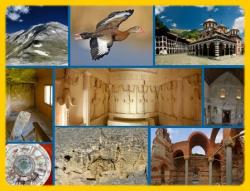 Bulgaria is a country with thousands of years of history and a cultural heritage that embraces ancient civilizations. Visitors will find much to interest them in the country’s history, culture, ethnography, religion, architecture and the arts. Unique archaeological sites abound throughout the country – ancient settlement mounds from the Neolithic age, Thracian sanctuaries and tombs, remains of Roman cities, Byzantine and Medieval fortresses, architectural reserves, ethnographic complexes, churches and monasteries, Tekkes (mosques), among many others.
Bulgaria is a country with thousands of years of history and a cultural heritage that embraces ancient civilizations. Visitors will find much to interest them in the country’s history, culture, ethnography, religion, architecture and the arts. Unique archaeological sites abound throughout the country – ancient settlement mounds from the Neolithic age, Thracian sanctuaries and tombs, remains of Roman cities, Byzantine and Medieval fortresses, architectural reserves, ethnographic complexes, churches and monasteries, Tekkes (mosques), among many others.
Despite the fact that it occupies only 2% of Europe’s territory, about 40,000 historical monuments have been registered in Bulgaria (7 of which are included in the UNESCO list of world cultural heritage sites), 36 cultural reserves, 160 monasteries, and roughly 330 museums and galleries. This includes prehistoric finds, Thracian tombs, sites from the Greek Age, Roman fortresses, historical monuments from the time of the First and the Second Bulgarian Kingdoms, and architectural landmarks from the Age of Revival.
Emblematic for Bulgaria are the monuments included in the UNESCO List: the Kazanlak Tomb (4th – 3rd century BC), the Thracian Tomb by the village of Sveshtari near Razgrad (3rd century BC), the Madara Horseman (8th century), the Boyana Church (10th – 11th century), the Ivanovo Rock Churches near Ruse (10th – 14th century), the Rila Monastery (10th century), the Old Town in Nesebar.
The Karanovska settlement mound provides a basis for determining the Karanovska Neolithic periods and serves as a model for understanding the development of European prehistoric cultures. Of great interest is the Valley of the Thracian Kings, in which more than 15 tombs have been discovered. Perperikon is also located in the territory of our country. It is considered to be the temple of God Dionysus containing a prophecy chamber equal in importance to the one dedicated to Apollo at Delphi. It is believed that this was the capital of the Odryssian Kingdom. The largest Thracian royal complex with a mausoleum temple in Southeast Europe was discovered in the region of the village of Starosel. The oldest gold in the world was discovered in the Varna necropolis. Many Thracian golden treasures have also been found, such as the Panagyurishte, Valchitran, and Rogozen treasures. There are numerous remains of the Thracian, Hellenistic and Roman culture. Entire Roman city complexes have been found at Augustra Trayana, Trimontium, Nikopolis ad Istrum, Pautalia, Akre, Mesemvria, Apolonia, Serdika, and other sites.
Many of Bulgaria’s monasteries have been instrumental in preserving the Bulgarian Orthodox faith and culture. Some of them are the Rila Monastery, Bachkovo Monastery, Troyan Monastery, Zemen Monastery, Rozhen Monastery, Kilifarevski Monastery, Sokolski Monastery, among others. In the country there are also many churches that house unique examples of the Bulgarian iconographic, woodcarving and painting schools and that possess valuable manuscripts. The relics of St. John the Baptist were found on the island of St. John off Bulgaria’s Black Sea coast.
Cultural monuments from the Bulgarian Revival period can be found in many of its cities, towns, and villages, such as those in Kotel, Koprivshtitsa, Karlovo, Kalofer, Sopot, Elena, Tryavna, Bansko, Melnik. the Old Plovdiv, Gela, Shiroka Laka, Momchilovtsi, Orehovo, Smilyan, Arda, Dolen, Leshten, Kovachevitsa, Pletena, Bozhentsi, Ribaritsa, Zheravna, Oreshak, Medven, Skandalo, Arbanasi, Balgari, Kosti, Brashlyan, and Mladezhko. There are many ways for visitors to appreciate Bulgarian crafts such as woodcarving, embroidery, pottery, and knitting. For example, there is the architectural and ethnographic open-air museum at Etara, near Gabrovo, the ethnographic complexes The Old Dobrich and Chiflika near Albena, Bansko, the ethnographic complex Kulata - Kazanlak, the ethnographic complex at Zlatograd, Varosha – Blagoevgrad, the ethnographic complex Brashlyan – Malko Tarnovo, and others.
There are also opportunities to observe traditional economic activities in our lands, such as the manufacture of rose oil and wine production.
Bulgaria has an exceptionally diverse calendar that preserves the country’s folk traditions and customs - Surva (St. Vasil’s Day), St. Jordan’s Day – Epiphany, St. John’s Day, St. Anton’s Day, Trifon Zarezan, Martuvane (giving martenitsas), the first Sunday before Lent, Mummer’s Day, St. Todor’s Day, the Annunciation Day, Easter, St. George’s Day, the Day of Virgin Mary, St. Dimitar’s Day, All Souls Day, Christmas Eve, and Christmas. Many Bulgarian village celebrations and folkways preserve ancient traditions and customs, such as St. Lazar’s Day, Palm Sunday, the mummers, carol singing, fire-dancing and many others. Exceptionally attractive are the folklore festivals and gatherings – for instance, the International Mummers Festival “Starchevata” (Razlog), the International Festival of Masquerade Games “Surva” (Pernik), the Ethnicities Gathering (municipality of Beloslav), the International Folklore Festival (Veliko Tarnovo), the National Folklore Festival “Rozhen”, the International Bagpipe Festival in the village of Gela, and many others.
There are more than 200 museums in the country - the unique Museum of Yogurt in the village of Studen Izvor (Tran region), the Museum of Roses in Kazanlak, the Museum of Transport in Ruse, the Museum of Fretwork in Tryavna, the Museum of Humor in Gabrovo, the Museum of Medical History in Varna, the Museum of Mosaics in Devnya, the Museum of Salt in the town of Pomorie, the Polytechnic Museum in Sofia City, the National Museum of Anthropology in Sofia, the Museum of Aviation in Plovdiv, the Museum of Wine in Pleven, the National History Museum, the museum “Earth and its People,” and many others.
The country’s calendar abounds in cultural events. Some of these are the Sofia Film Fest, the festival “Love is Folly” in Varna, the festival “Varna Summer”, the “Music Days in March” in Ruse, the “Sofia Music Weeks”, “Apolonia”, “Spirit of Burgas”, the Kavarna Rock Fest, and many others.
http://bulgariatravel.org |